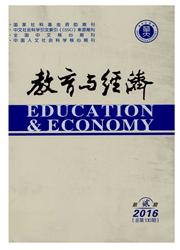

 中文摘要:
中文摘要:
采用2007和2011年国家统计局的教育支出专项调查数据,本文对义务教育阶段家庭教育支出的结构和不平等进行分析,通过两年数据的比较,研究发现:城镇居民家庭教育支出大幅增加的同时,家庭教育支出的结构发生了显著变化。一方面,校内教育支出得到了严格控制,低收入家庭支出的学杂费、书本费占收入比重明显下降,另一方面,各收入分位家庭的校外教育支出大幅增加,并体现出“刚性”特点。校内教育支出下降带来的“减负”无法弥补校外教育支出的“增负”;家庭收入越低,教育支出占收入的比重越大,低收入家庭承受的负担日益加重。此外,我们还发现外地农业户口的家庭并没有平等地从义务教育政策受益,相比其他户口类型的家庭,他们需要为子女在校内教育方面花费更多。
 英文摘要:
英文摘要:
Using the special education expenditure survey data from State Statistic Bureau from 2007 to 2011, this paper analyzes the formation and inequality of household education expenditure in compulsory education stages. By the comparing of data in two years, the study found that there is a significantly change in the formation of household education expenditure, following the great increase of urban household education expenditure. On one hand, the in-school education expenditure has been strictly curbed, so the proportion of tuition and textbook fees in the whole income of low income family has fallen down greatly; On the other hand, the education expenditure on outside school education of households in different income levels has grown obviously, and showing the characteristic of Rigidity. The decrease of in-school education expenditure cannot make up for the increase of education expenditure in outside school. The smaller the household income is, the bigger percentage it is in the whole education expenditure and the heavier burden it is for the low income family, s Moreover, we also provide evidence that non-local rural residents may not benefit equally from the compulsory education policy by the same extent as the local residents and thus have to spend more on the child' s in-school education.
 同期刊论文项目
同期刊论文项目
 同项目期刊论文
同项目期刊论文
 Trends in China’s gender employment and pay gap: estimating gender pay gaps with employment selectio
Trends in China’s gender employment and pay gap: estimating gender pay gaps with employment selectio Linking Gender Role Orientation to Subjective Career Success The Mediating Role of Psychological Cap
Linking Gender Role Orientation to Subjective Career Success The Mediating Role of Psychological Cap Effect of Organizational Politics on Employees’ Work Responsibility: Empirical Analysis Based on New
Effect of Organizational Politics on Employees’ Work Responsibility: Empirical Analysis Based on New Learning goal orientation and creative performance: The differential mediating roles of challenge an
Learning goal orientation and creative performance: The differential mediating roles of challenge an Roles of creative process engagement and leader-member exchange in critical thinking and employee cr
Roles of creative process engagement and leader-member exchange in critical thinking and employee cr Human Capital Investment in Children: An Empirical Study of Household Child Education Expenditure in
Human Capital Investment in Children: An Empirical Study of Household Child Education Expenditure in Evidence on the impact of sustained exposure to air pollution on life expectancy from China’s Huai R
Evidence on the impact of sustained exposure to air pollution on life expectancy from China’s Huai R Relational Versus Collective Identification Within Workgroups: Conceptualization, Measurement Develo
Relational Versus Collective Identification Within Workgroups: Conceptualization, Measurement Develo 期刊信息
期刊信息
